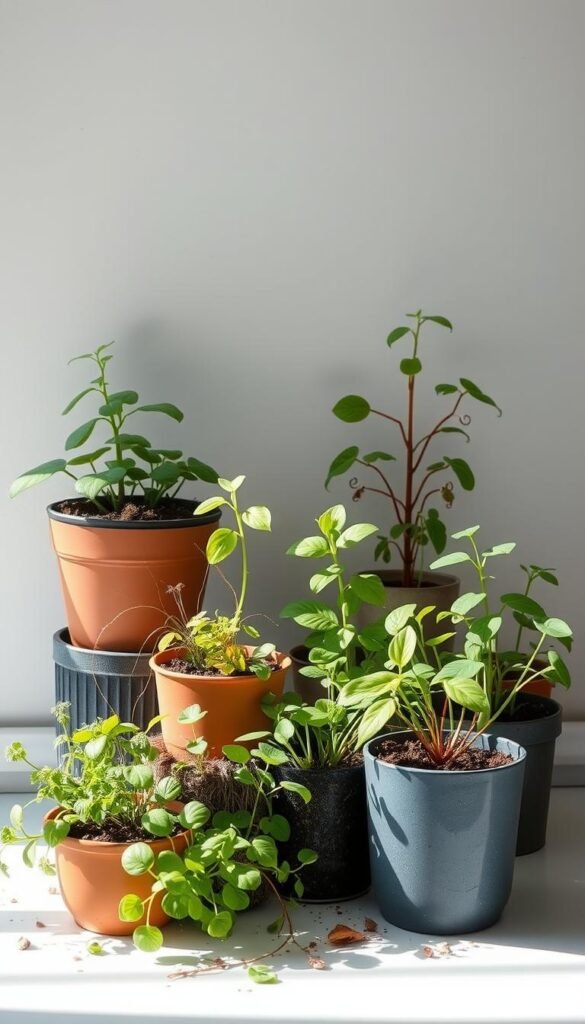Starting a garden in tight areas like balconies or patios feels exciting, but even seasoned growers face challenges. Take tomatoes, for example. Many beginners plant them in containers without realizing they need deep soil and daily care. VERANDA gardening experts warn this mistake often leads to weak roots and disappointing harvests. The lesson? Your plant choices shape your entire experience.
Gardening in limited spaces isn’t just about what you grow—it’s about how you approach it. One misstep early on, like overcrowding herbs or skipping sunlight checks, can ripple into bigger issues. But here’s the good news: every error teaches something valuable. Even pros admit they’ve lost plants to poor timing or cramped pots.
Success starts with mindset. Instead of frustration, focus on small wins. Did your basil thrive in a sunny corner? That’s progress! Pair this optimism with planning. Track sunlight patterns, research compact varieties, and leave room for adjustments. Time invested upfront saves headaches later.
Key Takeaways
- Plant selection directly impacts success in confined growing areas.
- Planning for sunlight, spacing, and growth habits prevents common setbacks.
- Early mistakes offer learning opportunities rather than reasons to quit.
- Balancing patience with practical adjustments keeps the process enjoyable.
- Expert insights help avoid repeating easily fixable errors.
Understanding the Challenges of Small Space Gardening
Working with tight growing areas means wrestling with nature’s rules in new ways. Limited root depth, unpredictable microclimates, and faster soil depletion test even confident growers. Urban horticulturist Rachel Summers notes:
“Container gardens dry out 30% faster than ground beds—miss one watering, and your plants pay the price.”
Your soil’s health becomes make-or-break in confined plots. Nutrient-rich mixes drain better but need monthly replenishment since roots can’t search wider areas for food. Compacted dirt starves plants, while overly loose blends wash away during storms.
Seasons play tricks in small spaces too. A sunny spring balcony might turn into a summer oven, scorching delicate greens. One gardener shared how her mint thrived in April shade but wilted by June when nearby buildings reflected heat. Tracking light shifts helps you adapt planting times.
Don’t let these hurdles discourage you. Focus on what you can control. Test soil pH every 3 months. Choose dwarf tomato varieties over sprawling zucchini. “Think vertical,” advises rooftop farmer Luis Torres. “A trellised cucumber uses 75% less floor space than bush types.”
Wind tunnels, partial shade, and reflected heat become part of your garden’s personality. Work with these quirks instead of fighting them. Kale might bolt faster near a hot wall, but Swiss chard could flourish there. It’s all about matching plants to your unique conditions.
Recognizing Your Garden’s Unique Constraints
Your garden’s personality isn’t just about plants—it’s shaped by hidden factors you might overlook. Take two balconies on the same street: one gets morning sun perfect for lettuce, while afternoon shade ruins tomato dreams next door. Landscape designer Mia Chen notes:
“People often copy neighbors’ gardens, not realizing their soil pH or wind patterns differ completely.”
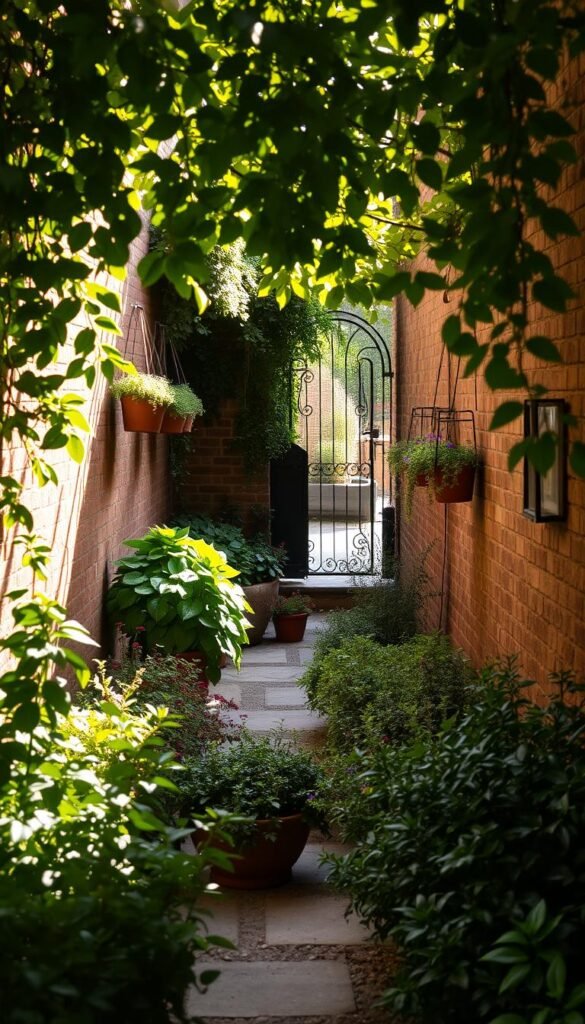
Start by mapping sunlight hourly for three days. Free apps like SunSeeker help, but even noting shadows with chalk works. A Brooklyn gardener discovered her “full sun” patio actually had 40% less light than expected—saving her from a basil disaster.
Soil tells its own story. Squeeze a handful: sandy dirt drains fast (great for rosemary), while clay holds moisture (ideal for ferns). Urban soils often lack nutrients due to pollution. Test kits under $15 reveal pH and mineral levels—knowledge that helps you amend dirt effectively.
Watch for microclimates. Reflective windows can fry mint in summer, while concrete walls radiate evening heat for peppers. One gardener grew dwarf kale successfully under air conditioner runoff—accidental irrigation!
The key thing? Pay attention early. Track changes across weeks, not days. Adjust plant choices as you learn your space’s quirks. Time invested here prevents wasted effort later, turning constraints into creative opportunities.
5 Common Mistakes in Small Space Gardening (And How to Avoid Them)
Growing plants in cozy urban spots brings joy, but hidden traps await. Many enthusiastic growers repeat errors that sabotage their efforts. Let’s uncover the top slip-ups—and smart fixes—to keep your green space thriving.
1. Flying Blind Without a Plan
Sarah, a Denver apartment gardener, learned this hard way. She bought plants impulsively, only to find her basil blocked sunlight from peppers. VERANDA’s experts stress: “Sketch your layout first—account for mature sizes and sun paths.” Track growth habits using free apps like Garden Planner.
2. Treating Soil Like Dirt
Urban soils often lack nutrients. Horticulturist Dr. Ellie Park warns:
“Container gardens need fresh compost every 8 weeks—think of soil as a pantry, not just anchor.”
Test kits reveal pH imbalances that stunt growth. Mix in worm castings for slow-release nutrition.
3. Crowding the Party
Three cilantro plants in a 10-inch pot? Recipe for wilt. Leave breathing room—compact varieties like ‘Patio Baby’ eggplants need 18-inch spacing. Rotate crops seasonally to prevent nutrient wars.
4. Ignoring Light Shifts
Jake’s Brooklyn fire escape tomatoes failed when summer sun moved. Use a sun calculator app or simple chalk marks to track patterns monthly. Adjust plant positions as seasons change.
5. Wasting Vertical Real Estate
Rooftop grower Luis Torres tripled yields using trellises: “Cucumbers climb, strawberries cascade—upward designs multiply harvests.” Install wall planters or tiered shelves to exploit every inch.
Spotting these pitfalls early saves time and heartache. Your garden’s success lies in adapting as you learn—one thoughtful adjustment at a time.
Starting with the Right Plants for Your Space
Choosing plants for compact gardens is like matchmaking—pairing growth habits with your space’s limits creates lasting relationships. Remember those tomatoes struggling in shallow pots? Leafy greens like spinach or kale offer better odds for beginners. Their shallow roots adapt to containers, while quick harvests boost confidence. As urban gardener Nina Patel advises:
“Success with lettuce builds courage to try peppers later. Master the basics before tackling finicky crops.”
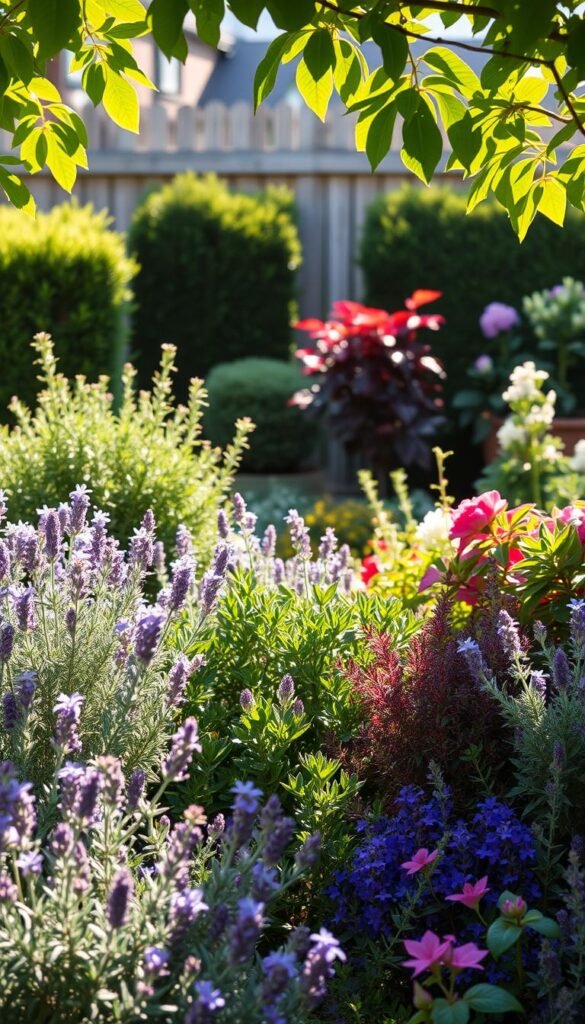
Focus on plants that forgive learning curves. Herbs like basil and mint thrive with minimal fuss, while radishes mature in 30 days. These quick wins keep your garden productive while you learn light patterns and watering rhythms. Dwarf varieties of cherry tomatoes or bush beans work too—just ensure containers are deep enough for their roots.
Root development matters more than you think. Plants with compact systems (think arugula, not carrots) handle confined spaces better. Check seed packets for terms like “container-friendly” or “patio type.” Vertical growers like peas use trellises wisely, freeing floor space for trailing nasturtiums.
Three expert tips to start strong:
- Test two easy plants first—compare their needs
- Upgrade soil depth gradually as skills improve
- Track growth weekly to spot issues early
Your garden’s foundation isn’t dirt or pots—it’s smart plant choices. Build skills with low-stakes greens before investing time in temperamental stars. Every harvest, even small, proves your space can flourish.
The Importance of Healthy Soil and Effective Mulching
Think of your garden’s soil as its kitchen—it’s where plants grab meals and build strength. In tight spaces, every scoop matters. Nutrient-rich dirt feeds roots better than bargain soil bags, while poor mixes leave plants hungry. VERANDA experts note: “Container gardens lose fertility faster—refresh soil every 6-8 weeks for peak performance.”
Test your soil’s health with a simple squeeze test. If it crumbles like chocolate cake, you’re golden. Clumpy or sandy? Mix in compost or worm castings. Urban gardener Linh Tran shares:
“Adding coffee grounds boosted my basil’s flavor—free kitchen scraps became plant superfood!”
Mulch acts like a moisture-saving blanket. A 2-inch layer of straw or shredded bark slows evaporation, giving roots more time to drink. It also fights weeds that steal nutrients. Skip wood chips in pots—they’re too heavy. Try cocoa hulls or leaf mold instead.
Healthy soil prevents common issues like yellow leaves or stunted growth. Balance is key: too much water drowns roots, while compacted dirt chokes them. Check moisture by poking a finger an inch deep—if it’s dry, water slowly at the base.
Your garden thrives when dirt works smarter, not harder. Feed it organic matter, shield it with mulch, and watch even tiny spaces burst with life.
Comprehensive Garden Planning for Limited Areas
Transforming small outdoor spaces into thriving gardens begins with a roadmap. Landscape designer Fernando Wong emphasizes:
“Phased installations let you build beauty and budget control—start with structural elements before adding decorative layers.”
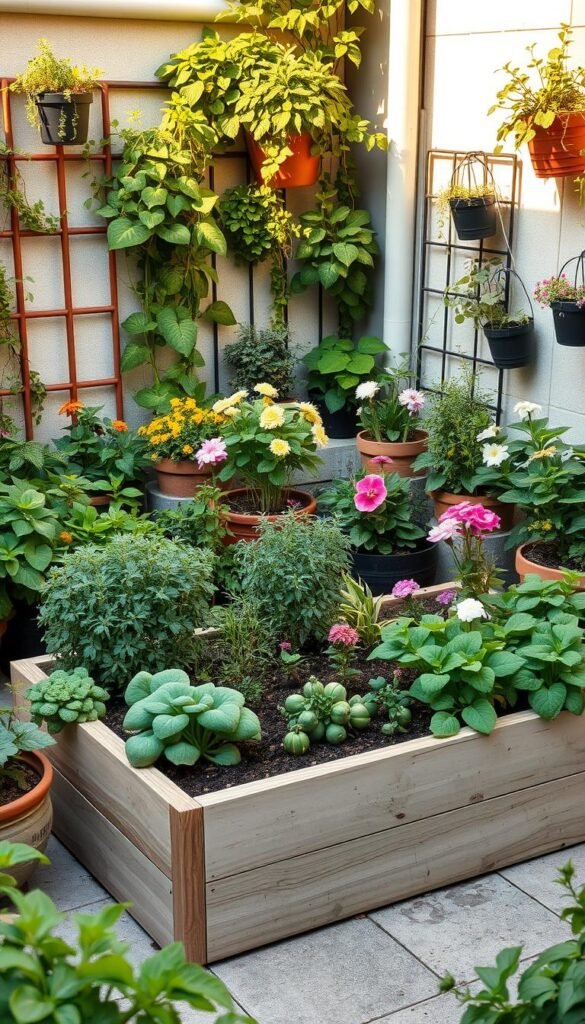
A thoughtful plan accounts for sunlight patterns, mature plant sizes, and seasonal changes. Sketch your layout using grid paper or apps like SmartDraw. Mark existing features like walls or drains first—these dictate where garden beds can thrive.
| Aspect | Quick Fix | Comprehensive Plan |
|---|---|---|
| Design | Random plant placement | Sunlight-mapped zones |
| Budgeting | Overspending on impulse buys | Phased purchases over 3 seasons |
| Execution | One-week frenzy | Monthly priority projects |
| Results | Patchy growth | Cohesive, thriving ecosystem |
Start by testing one bed or container cluster. Track how morning light hits your space for a week—adjust plant choices based on real data. Mix quick-growing radishes with slower herbs to maintain visual interest while waiting for larger crops.
Divide projects into phases:
- Year 1: Build foundational soil and key structures
- Year 2: Expand vertical growing systems
- Year 3: Add decorative accents like trellises
This staggered approach spreads costs and lets you refine techniques. Remember—your garden evolves. Leave room to swap plants as you learn what thrives in your microclimate.
Mastering Seed Sowing and Germination Techniques
The journey from seed to seedling is a delicate dance of timing and technique. Many gardeners rush this process, only to face patchy sprouts or empty pots. Urban horticulturist Dr. Elena Moss explains:
“Seeds aren’t just tiny dots—they’re living blueprints needing precise conditions to awaken.”
| Error | Quick Fix | Best Practice |
|---|---|---|
| Buried too deep | Use ruler for ¼-inch depth | Follow packet instructions |
| Wrong soil mix | Buy seed-starter blend | Add perlite for drainage |
| Overwatering | Mist with spray bottle | Keep soil damp, not soggy |
| Poor labeling | Use popsicle sticks | Note planting date/variety |
Timing matters as much as technique. Start cool-weather crops like spinach 4 weeks before last frost. Warm-season plants like basil need steady 70°F soil. Test your garden’s microclimate by placing a thermometer near planting areas.
Pay attention to watering tools. A heavy hose stream displaces seeds—opt for a fine mister instead. One gardener doubled her germination rate by watering at dawn when soil absorbs moisture slowly.
Three pro tips for success:
- Scarify tough seed coats with sandpaper
- Pre-soak peas overnight to speed growth
- Rotate trays daily for even light exposure
Your seeds hold magic waiting to unfold. With the right care, even a windowsill can become a nursery of green promise.
Avoiding Overcrowding in Your Garden Beds
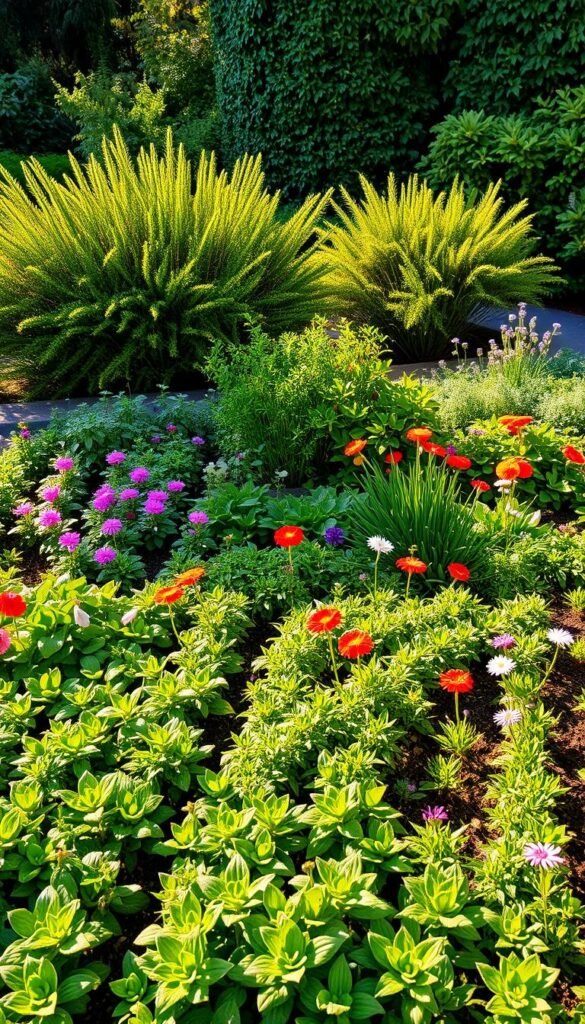
Plants need personal space too—just like people, they thrive when given room to breathe. Crowding your garden beds creates a survival race where roots fight for nutrients and leaves battle for sunlight. Urban gardener Layla Nguyen shares:
“I lost an entire basil crop because parsley overshadowed it. Now I measure spacing like I’m arranging furniture.”
Overplanting limits air movement, creating humid pockets where mildew thrives. Tomatoes spaced 24 inches apart resist blight better than those crammed 12 inches apart. Use seed packet guides as starting points, but add 10% extra space for container plants.
Three signs your plants need breathing room:
- Yellowing lower leaves despite proper watering
- Stunted growth compared to solo plants
- Frequent pest infestations
Plan your garden beds using the “mature size rule.” If a plant grows 18 inches wide, center it with 9 inches clear on all sides. Stagger planting times—sow quick-growing radishes between slower broccoli. Harvest the radishes before the broccoli needs the space.
When seedlings sprout too close, thin them ruthlessly. Snip extras at soil level instead of pulling to protect nearby roots. For carrots and beets, this step is non-negotiable—their taproots demand unobstructed downward paths.
Remember: Your garden isn’t static. Move plants that outgrow their spots. Swap sprawling zucchini for compact peppers mid-season if needed. Adapting as plants grow prevents long-term damage and keeps your green space productive.
Effective Watering Techniques for Small Gardens
Watering small gardens feels simple until your basil turns crispy while nearby mint drowns. The secret? Precision beats guesswork. Drip irrigation systems deliver moisture straight to roots, cutting waste by 50% compared to sprinklers. Urban farmer Jenna Lee notes:
“Overhead watering after noon invites mildew. Always hydrate roots, not leaves.”
Tomatoes show why technique matters. Splitting fruits often trace to uneven soil moisture—drip lines prevent this by maintaining steady hydration. Check soil daily: if the top inch feels dry, water slowly at the base.
| Method | Efficiency | Disease Risk | Best For |
|---|---|---|---|
| Drip Irrigation | High | Low | Containers, raised beds |
| Soaker Hose | Medium | Medium | Row crops, shrubs |
| Overhead | Low | High | Seedlings (morning only) |
Morning watering gives plants time to dry, reducing fungal threats. For seedlings, use a gentle spray bottle until roots establish. Self-watering pots with reservoirs help during vacations—they release moisture as needed.
Make sure your routine adapts to seasons. Summer might need daily attention, while spring calls for weekly checks. Track rainfall with a simple cup gauge. Your garden thrives when water becomes a tailored tool, not a chore.
Tips for Successful Transplanting and Seedling Care
Moving young plants to their forever home requires a gentle touch—rush this process, and you risk stunted growth or wilted leaves. Start by watering seedlings thoroughly an hour before transplanting. This hydrates roots and helps soil hold together during the move.
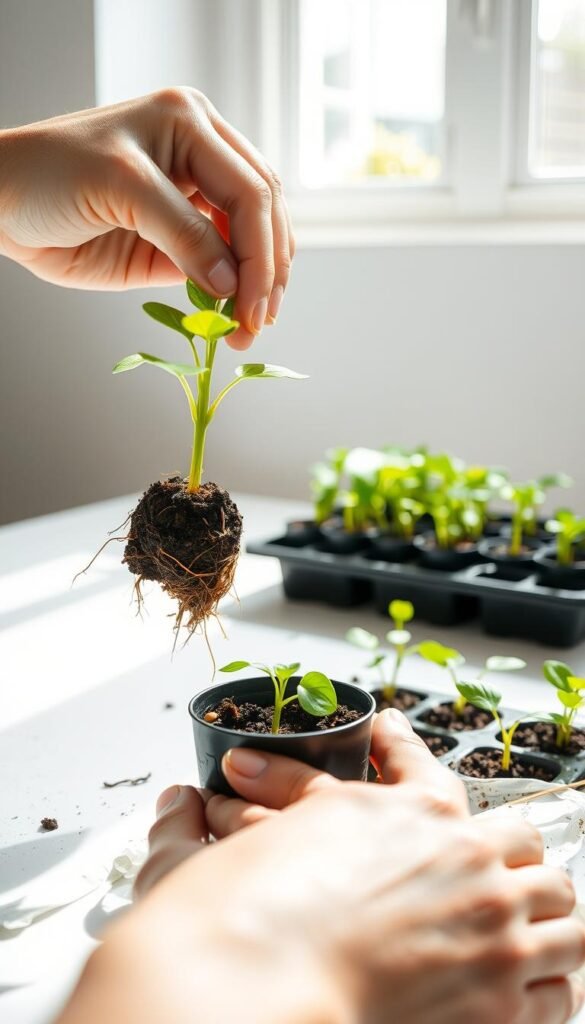
Always handle plants by their leaves, not stems. As urban gardener Priya Kapoor explains:
“Squeezing stems damages delicate vascular tissues. Leaves heal faster if accidentally bruised.”
Use a spoon to lift seedlings from trays, keeping the root ball intact. Tease apart tangled roots gently to encourage outward growth.
Spacing matters even at this stage. Follow these guidelines for common garden starters:
- Leafy greens: 6-8 inches apart
- Tomatoes: 18-24 inches between plants
- Herbs: 10 inches for bushy varieties
Time your transplant for late afternoon or cloudy days. This gives plants 12+ hours to adjust before facing harsh sun. Shield new transplants with shade cloth for 2-3 days if heat waves hit.
Resist the urge to fertilize immediately—wait until you see new growth. Overeager feeding burns tender roots. Your patience now ensures stronger plants that withstand pests and weather shifts later.
Seasonal Considerations and Climate-Appropriate Planting
Your garden dances to nature’s calendar—each season whispers new possibilities and challenges. What thrives in July might struggle in October, even if temperatures seem similar. Urban horticulturist Marco Reyes observes:
“A zucchini planted too late misses its pollination window, while fall kale gains sweetness after frost.”
Make sure your plant choices match local weather patterns. Track frost dates using apps like Farmers’ Almanac, and note microclimates—south-facing walls create warm pockets for early spring peas.
Winter planning saves money and time. Buy seeds during January sales, and start cold-hardy varieties indoors. A Chicago gardener grew lettuce year-round using $15 grow lights, harvesting 3 weeks faster than outdoor plots.
| Season | Tasks | Smart Plants |
|---|---|---|
| Spring | Soil prep, cool crops | Spinach, radishes |
| Summer | Pest checks, heat lovers | Basil, peppers |
| Fall | Extend harvests | Kale, carrots |
| Winter | Plan, protect perennials | Garlic (planted) |
Adapt your garden budget seasonally. Invest in row covers instead of replacing frost-bitten tomatoes. Make sure to rotate crops—beans replenish soil nitrogen spent by summer corn.
Watch for subtle shifts. Early blooms might signal earlier last frosts. Your garden becomes a living notebook, teaching you to read nature’s cues while stretching your growing season.
Leveraging Design and Aesthetics in Tight Spaces
Your compact garden isn’t just a plant collection—it’s a living canvas waiting for creative touches. Landscape designer Mara Santos suggests:
“Treat vertical surfaces as prime real estate. A wall-mounted herb spiral or cascading petunias adds depth without eating floor space.”
Balance bold colors with calming greens to avoid visual chaos. Pair purple sage with silver-toned dusty miller, or let fiery nasturtiums pop against muted succulents. This contrast creates focal points that guide the eye through your garden.
Your environment dictates design choices. Shady corners shine with variegated hostas and ferns, while sunny spots dazzle with compact sunflowers. Pay attention to how light shifts—place reflective ornaments where they’ll catch afternoon rays.
Three tips for visual flow:
- Use odd-numbered plant groupings (3 or 5) for natural rhythm
- Repeat one color across different areas to unify the space
- Elevate trailing plants in hanging baskets to create layers
Don’t underestimate decorative elements. A cobalt-blue pot becomes art when filled with lemon thyme. Wind chimes double as pest deterrents while adding movement. Your garden becomes an extension of your style—playful, serene, or boldly modern.
Remember: Great design works with your environment, not against it. A narrow balcony might inspire a sleek vertical jungle, while a tiny patio could transform into a cottagecore retreat. Every choice, from plant placement to decor, turns limitations into curated beauty.
Incorporating Wildlife-Friendly Practices into Your Garden
Your garden thrives when it becomes a hub for nature’s helpers. Birds snatch aphids off your roses, while ladybugs devour mites that threaten herbs. By avoiding harsh pesticides, you create a balanced environment where beneficial creatures handle pest control naturally. As ecologist Dr. Maya Carter notes:
“A single chickadee family eats 6,000 caterpillars during nesting season—that’s free pest management with feathers!”
Start by planting native species like milkweed or coneflower. These attract pollinators while requiring less water—a win for your garden and local ecosystems. Leave seed heads standing through winter to feed finches, and add a shallow water dish for thirsty bees.
| Traditional Approach | Wildlife-Friendly Fix | Result |
|---|---|---|
| Chemical sprays | Plant marigolds to repel nematodes | Healthier soil, fewer plants die |
| Neatly raked beds | Leave leaf litter for beetle habitats | Natural decomposition enriches dirt |
| Single-species rows | Mix flowers with veggies | Higher pollination rates |
Three steps to transform your space:
- Swap insecticides for companion planting—basil protects tomatoes from flies
- Install a certified wildlife habitat garden sign to track progress
- Let clover grow between pavers—it fixes nitrogen and feeds rabbits
When plants die, resist the urge to clear them immediately. Hollow stems shelter overwintering bees. Your patience rewards you each spring—a lively garden buzzing with life proves nature’s wisdom beats chemicals every time.
Experimenting and Learning from Small Space Garden Trials
What if every wilted leaf or stunted plant became your greatest teacher? Urban gardener Tessa Morales discovered this mindset shift after her first failed balcony tomatoes:
“Those crispy vines taught me more about sun patterns than any book could. Now I celebrate ‘plant fails’ as progress markers.”
Your garden thrives when you treat experiments as data collection. Track how different herbs respond to afternoon shade over time. Note which varieties bounce back after dry spells. This hands-on research builds wisdom no generic advice can match.
| Trial | Observation | Adjustment |
|---|---|---|
| Basil in shallow pots | Leaves yellowed at 3 weeks | Switched to 12-inch deep containers |
| Peppers near AC unit | Slow growth, fewer blooms | Moved to wind-protected corner |
| Mint without drainage | Root rot in 10 days | Added perlite to soil mix |
Notice patterns across seasons. Arugula that bolted quickly last summer might thrive in your fall garden with cooler nights. Share findings with others—online forums love hearing what works in unique spaces.
Keep a simple journal. Sketch plant positions monthly, note weather extremes, and rate harvest quality. Over time, these records reveal your garden’s hidden rules. One Brooklyn grower realized her zucchini needed 30% less water than seed packets suggested—all thanks to weekly notes.
Remember: Every pro gardener once killed a lot of plants. Your willingness to test, observe, and adapt turns setbacks into stepping stones. Those ‘failed’ radishes? They just taught you about soil depth.
Budget-Friendly Gardening: Maximizing Your Investment
Creating a thriving garden doesn’t require deep pockets—just smart strategies. Start by repurposing household items. Old colanders become herb planters, while milk jugs transform into seedling protectors. As urban gardener Malik Thompson shares:
“My best tomato crop grew in recycled paint buckets—drilled holes cost nothing, and they lasted three seasons.”
Smart planning saves money and time. Sketch your layout before buying supplies. Measure spaces to avoid overspending on unnecessary pots or soil. Free apps like Planter help visualize mature plant sizes, preventing costly overcrowding mistakes.
| Expensive Option | Budget Swap | Savings |
|---|---|---|
| $40 ceramic pot | Repurposed storage bin | $35 |
| Premium potting mix | Homemade compost blend | $20 per bag |
| Seed starter kits | Egg cartons + plastic wrap | $15 |
Choose plants that multiply your investment. Perennial herbs like oregano come back yearly, while fast-growing lettuce provides quick harvests. Swap pricey annuals with self-seeding flowers like marigolds—they’ll brighten your garden for free next spring.
Seasoned gardeners know durability beats trends. Invest in UV-resistant containers that won’t crack after one summer. Buy seeds in bulk with neighbors—a $4 packet split four ways cuts costs without sacrificing variety.
Your results depend on creativity, not cash. Track what thrives in your microclimate through simple trials. A little advice from local nurseries helps too—they often share free cuttings or discount imperfect plants that still grow beautifully.
Conclusion
Every thriving garden begins with understanding its unique needs. Whether nurturing basil in window boxes or tomatoes on fire escapes, your space holds potential when you work with its limits rather than against them. Mistakes like crowded roots or overlooked soil breaks aren’t failures—they’re stepping stones to greener thumbs.
Reflect on what your garden teaches. Did kale leaves flourish in partial shade? Did rosemary thrive in sandy soil? These discoveries shape smarter choices over time. Prioritize soil health and root care, and watch even modest plots burst with life.
Your journey matters as much as the harvest. Celebrate peppers that survived heatwaves and herbs that bounced back from overwatering. Each season offers fresh insights—if you stay curious.
Ready to grow? Start small. Test one tip from this guide, like vertical planting or morning watering. Observe how your garden responds, then build from there. With patience and attention, you’ll transform challenges into lush, vibrant corners that nourish both plants and pride.

